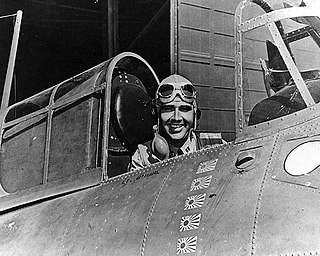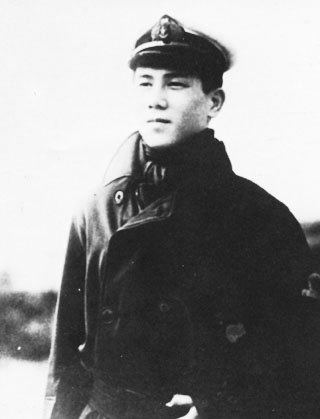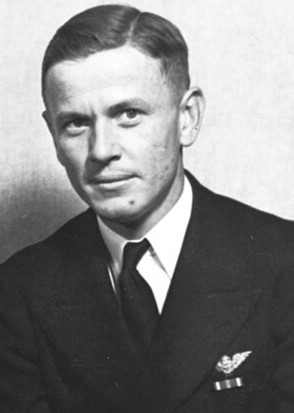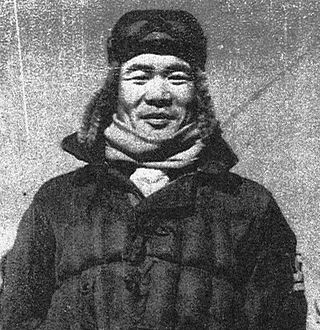
Lieutenant Commander Edward Henry O'Hare was an American naval aviator of the United States Navy, who on February 20, 1942, became the Navy's first fighter ace of the war when he single-handedly attacked a formation of nine medium bombers approaching his aircraft carrier. Even though he had a limited amount of ammunition, he was credited with shooting down five enemy bombers and became the first naval aviator recipient of the Medal of Honor in World War II.

John Smith Thach was a World War II Naval Aviator, air combat tactician, and United States Navy admiral. Thach developed the Thach Weave, a combat flight formation which could counter enemy fighters of superior performance, and later the big blue blanket, an aerial defense against kamikaze attacks.

The Thach weave is an aerial combat tactic that was developed by naval aviator John S. Thach and named by James H. Flatley of the United States Navy soon after the United States' entry into World War II.

Shōhō was a light aircraft carrier of the Imperial Japanese Navy. Originally built as the submarine support ship Tsurugizaki in the late 1930s, she was converted before the Pacific War into an aircraft carrier and renamed. Completed in early 1942, the ship supported the invasion forces in Operation MO, the invasion of Port Moresby, New Guinea, and was sunk by American carrier aircraft on her first combat operation during the Battle of the Coral Sea on 7 May. Shōhō was the first Japanese aircraft carrier to be sunk during World War II.

The Grumman F4F Wildcat is an American carrier-based fighter aircraft that entered service in 1940 with the United States Navy, and the British Royal Navy where it was initially known as the Martlet. First used by the British in the North Atlantic, the Wildcat was the only effective fighter available to the United States Navy and Marine Corps in the Pacific Theater during the early part of the Second World War. The disappointing Brewster Buffalo was withdrawn in favor of the Wildcat and replaced as aircraft became available.

Lieutenant CommanderJunichi Sasai was a Japanese naval aviator and fighter ace of the Imperial Japanese Navy during World War II. Sasai was killed leading his fighter squadron during an attack on Henderson Field during the Battle of Guadalcanal.

John Thomas Blackburn was an American naval aviator, World War II flying ace, and the first commanding officer of the famed F4U Corsair squadron VF-17 Jolly Rogers.

Lance Edward "Lem" Massey was a U.S. Navy pilot during World War II.
Fighting Squadron 2 or VF-2 was an aviation unit of the United States Navy. Originally established as VF-2 on 1 January 1927, it was redesignated VF-2B on 1 July 1927, redesignated as VF-2S on 1 July 1932, redesignated as VF-2B in April 1933, redesignated as VF-2 on 1 July 1937, it was disestablished on 1 July 1942. It was the second US Navy squadron to be designated as VF-2.

Ira Cassius Kepford was an American flying ace of World War II who served with a land-based unit of the United States Navy. In 76 days of combat flying with the VF-17 "Jolly Rogers," he was credited with shooting down 16 enemy aircraft. At the close of his combat service in April 1944, Kepford was the Navy's leading ace.

Stanley Winfield "Swede" Vejtasa was a United States Navy career officer and World War II flying ace. During the Battle of the Santa Cruz Islands, he was credited with downing seven Japanese aircraft in one mission, becoming an "ace in a day".

Hideki Shingō was a fighter pilot officer in the Imperial Japanese Navy (IJN) during World War II. He participated in various battles and campaigns throughout the Pacific War and survived the war.

Ayao Shirane was a fighter ace in the Imperial Japanese Navy (IJN) during World War II. He participated in various battles and campaigns throughout the Pacific War and was eventually shot down and killed over Leyte, Philippines on 24 November 1944. He was officially credited with destroying nine enemy aircraft.

Sadamu Takahashi was a dive bomber pilot officer in the Imperial Japanese Navy (IJN) during World War II. He is best known for being the Zuikaku's dive bomber squadron during the Battle of the Eastern Solomons and the Battle of the Santa Cruz Islands. He survived the war and later served in the Japan Self-Defense Forces retiring in 1970 with the rank of Vice Admiral.
Paul Hubert Ramsey was a World War II naval aviator of the United States Navy (USN).

Kakuichi Takahashi was a dive bomber pilot officer in the Imperial Japanese Navy (IJN) during World War II. He is best known for leading several strikes against the United States Navy during the Battle of the Coral Sea, where they sank the carrier Lexington, the oiler Neosho and the destroyer Sims, and damaged Yorktown. He was killed in action during the final stages of the battle.

The Battle of the Santa Cruz Islands was fought 25–27 October 1942 in the waters northwest of the Santa Cruz Islands by forces of the Imperial Japanese Navy's (IJN) Combined Fleet and the United States Navy's (USN) Pacific Fleet. The battle resulted from a major Japanese offensive with the goal to drive the US forces from Guadalcanal.
Moriyasu Hidaka was a fighter pilot officer in the Imperial Japanese Navy (IJN) during World War II. He participated in various battles and campaigns throughout the Pacific War and survived the war.

Elbert Scott McCuskey (1915–1997) was a World War II US Navy fighter ace. He participated in the Battle of the Coral Sea and the Battle of Midway, for which he was awarded two Navy Crosses, one for each battle. By the end of the war, he was credited with 13+1⁄2 aerial victories.

Iyōzō Fujita was an officer and ace fighter pilot in the Imperial Japanese Navy (IJN) during the Pacific War. He was officially credited with destroying 13 enemy aircraft. During the Battle of Midway alone, he claimed ten aircraft shot down in one day.





















